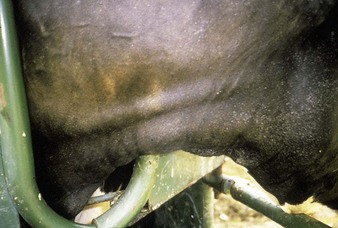Chapter 6 Cardiovascular disorders
Introduction
This chapter is short not because cardiovascular disorders are uncommon, but because many conditions are illustrated in other chapters. Three basic cardiac syndromes encompass most disorders: the first is congestive cardiac failure, which may result from valvular disease (6.4), myocardial or pericardial disease (6.5–6.8), hypertension, or congenital defects which produce shunts (1.30–1.32). Secondly, and less commonly, acute heart failure can result from tachyarrhythmia caused by a nutritional deficiency myopathy (e.g., copper or selenium), electrocution or lightning strike (classified under nervous disorders, 9.41–9.44), or bradycardia due to plant poisoning by Solanum, Trisetum and Lantana species, all of which can induce myocardial changes (13.13–13.16). Thirdly, peripheral circulatory failure can result from vasodilatation and a reduced circulating blood volume as in septic shock (e.g., acute gangrenous mastitis and acute metritis), or endotoxic shock from a peracute coliform mastitis (11.4–11.9). Peripheral circulatory failure can also be due to hematogenic failure as a result of severe hemorrhage (see 5.34), or as a consequence of neonatal calf diarrhea (2.16–2.24).
Congestive cardiac failure
Clinical features
following right-sided failure of the heart to pump an adequate volume of blood to the lungs, jugular venous distension (“jugular cording”) may be marked as seen in the Friesian cow in 6.1. The cow was dull, pyrexic, and developed a chronic cough as a result of passive venous congestion. Poor venous return in the Limousin cross bull (6.2) resulted in the development of a dependent edema in the submandibular, presternal, and ventral abdominal and preputial areas.
< div class='tao-gold-member'>
Stay updated, free articles. Join our Telegram channel

Full access? Get Clinical Tree



